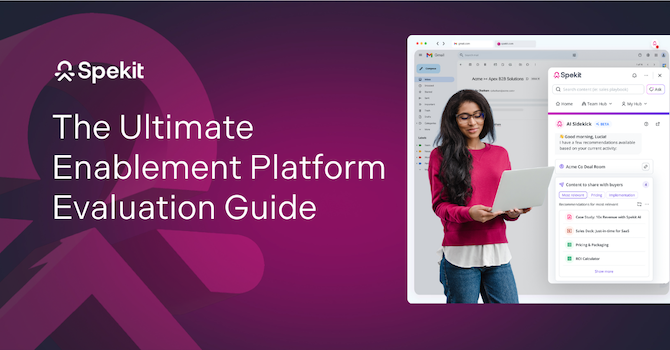Being “busy” all day but feeling like you’ve accomplished nothing is its own kind of frustration. You sit through demos, fire off follow-ups, update the CRM like clockwork, but by the end of the day, the pipeline’s still thin, and your number hasn’t budged.
The problem isn’t that you didn’t put in effort. It’s that you spend too much time doing admin work, juggling browser tabs, and making manual updates instead of actually selling.
But there’s a fix: sales productivity tools. These (often AI-powered) platforms quietly handle the repetitive tasks that drain focus, so reps can spend their time building relationships, conversing with prospects, and closing deals.
In this guide, we’re breaking down 17 of the best sales productivity tools built to automate and accelerate every part of the sales process.
What to look for in a sales productivity tool
Every sales productivity tool claims it’ll “transform” the way your reps sell. But they won’t all deliver on that flashy promise. You need to distinguish which tools actually have the potential to help sales reps ramp quicker, cut through admin drag, and spend more time on the work that moves deals forward.
Here’s what to look for when selecting a sales productivity tool.
- Features that don’t disrupt their workflow: Productivity tools should work inside the platforms reps already use (Salesforce, Gmail, LinkedIn), so reps don’t lose time switching tabs.
- Solutions to a specific friction point: They should remove a specific barrier that slows selling, such as manual follow-ups, disorganized content, or vague insights.
- Simplicity in setup, adoption, and scaling: Productivity tools should be quick to implement, intuitive to use, and flexible enough to grow as your team and processes evolve.
- Seamless connections with your tech stack: They should integrate smoothly with CRMs, engagement platforms, and other sales tools to prevent duplicate work and keep data consistent.
- Analytics that prove the tool’s impact: Built-in reporting should show adoption, performance impact, and ROI so you can see exactly how the tool drives results.
Read: How to measure sales productivity
17 sales productivity tools for a more efficient team
Here’s a quick breakdown of what each sales productivity tool is best for and the positive impact it can have on your team.
1. Spekit – The sales productivity tool for AI-powered enablement, automation, and Just-in-Time guidance
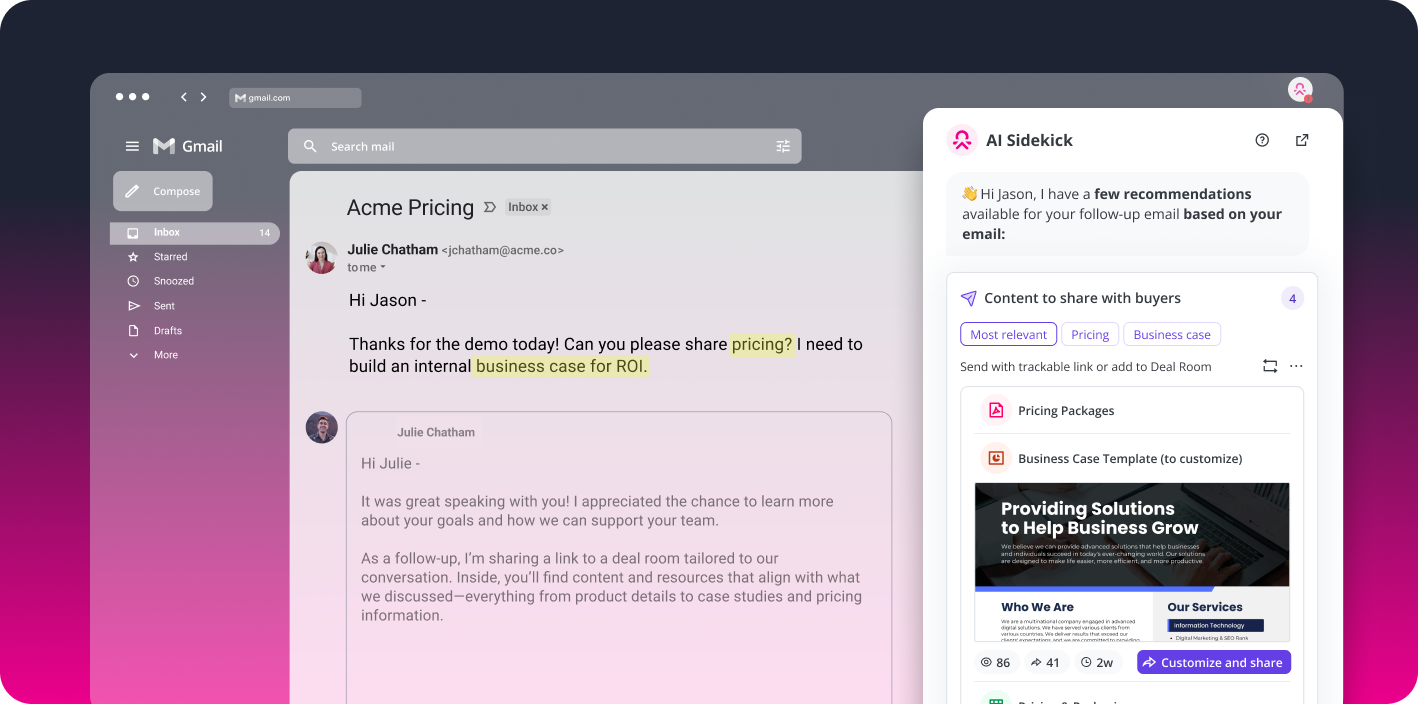
Spekit is the modern AI-powered enablement platform that unifies sales content, learning, and personalized guidance to help revenue teams automate workflows and close deals faster.
As a sales productivity tool, it removes friction from the sales process by delivering just-in-time enablement that keeps reps moving forward.
That means, instead of wasting time hunting through folders, Slack threads, or outdated decks, reps get instant, in-the-flow access to the resources, coaching, and context they need. It doesn’t matter if they’re prepping for a call, writing an email, or working a deal in Salesforce, Spekit will appear and prompt them.
Key features of Spekit:
- AI-governed repository: Consolidates all sales content, processes, and training into one source of truth, so reps can find resources easily.
- AI Sidekick: Acts as a contextual assistant, pulling from CRM data, call transcripts, and emails to surface personalized coaching, messaging support, and answers.
- AI content recommendations: Suggests the most relevant playbooks, case studies, or one-pagers based on the deal context, which helps reps prepare for calls and follow-ups faster.
- Speks: Bite-sized, searchable content embedded as tooltips inside the apps reps already use, such as Salesforce, Gmail, or Slack.
- Spotlights: Allows managers to send in-app alerts to notify reps of important changes, process updates, new content, or upcoming training.
- Knowledge Checks: Reinforces learning with quick in-app quizzes that track adoption and help managers identify knowledge gaps.
- Deal rooms: Creates collaborative spaces where reps and buyers can access shared content, proposals, and updates, along with analytics that track buyer engagement.
- Browser extension: Extends Spekit’s capabilities into any web-based app, allowing reps to access AI Sidekick and knowledge from anywhere they work

How Spekit makes your sales team more productive
In addition to serving as the central, AI-governed repository for all your up-to-date enablement content, training, and playbooks, Spekit boosts rep productivity by:
- Reducing time spent searching for content
- Automating content recommendations
- Accelerating onboarding and ramp
- Improving CRM data hygiene by guiding reps through processes and definitions as they work
- Streamlining change management by replacing scattered announcements with in-app Spotlights
- Driving faster follow-ups by surfacing relevant buyer content post-call or mid-email
- Cutting down on manager interruptions by empowering reps to self-serve answers and guidance
- Saving enablement teams time through AI-powered content creation and automated delivery, reducing manual effort
Companies are already seeing measurable gains in rep productivity and performance with Spekit’s AI sales enablement. ZoomInfo is a prime example:
“We had a major process change that affected a big chunk of our sales team,” says Luke Martin, Senior Manager of Revenue Enablement Infrastructure & Operations at ZoomInfo. “When we relied on newsletters, only 26 account managers saw it. When we ran the same update through Spekit, that number tripled.”
And the impact didn’t stop there.
By using Spekit’s Spotlights and Speks to deliver layered, in-the-moment learning, ZoomInfo enabled its reps to properly log over 1,100 demo calls in just one month.
“When we calculated the impact based on average sales price, we realized we had recovered millions of dollars in pipeline,” Luke says. “And the best part? We could directly attribute it back to our enablement efforts.”
Read: ZoomInfo unlocks millions in pipeline and triples engagement with Spekit
2. Gong – Sales productivity tool for conversation intelligence and sales coaching
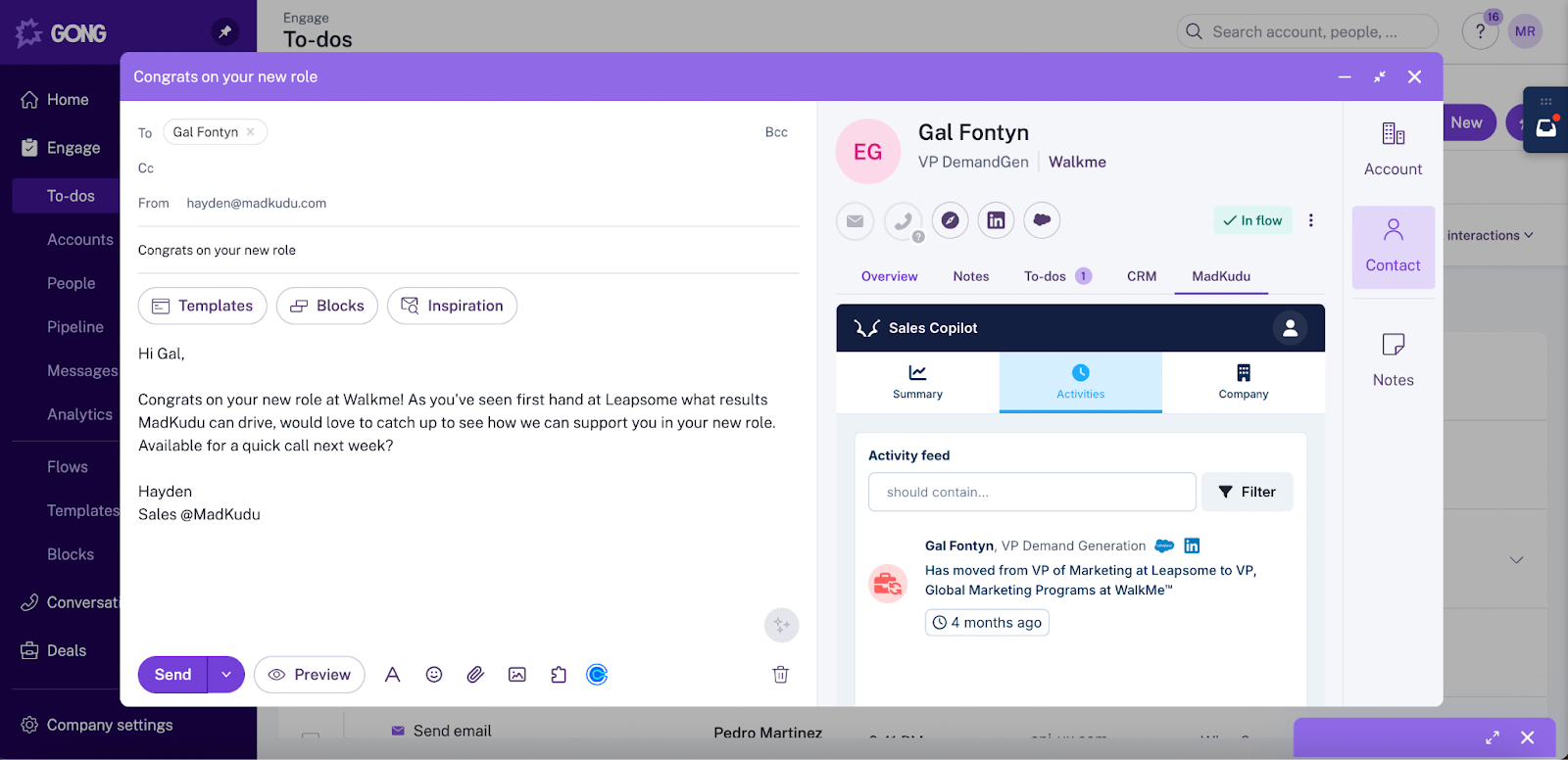
Gong is a revenue intelligence platform that records, transcribes, and analyzes sales conversations to give teams actionable insights.
By capturing every customer interaction and using AI to surface effective sales tactics, this platform helps reps improve their performance, managers deliver targeted coaching, and leaders forecast with greater accuracy.
Key features of Gong:
- Call recording and transcription: Automatically records and transcribes sales calls/meetings on platforms like Zoom and Microsoft Teams, to create a complete record of every conversation.
- Interaction insights: Analyzes call transcripts with AI and NLP (Natural Language Processing) to flag topics, competitor mentions, customer sentiment, and effective sales techniques.
- Deal boards: Provides a visual, real-time dashboard of the entire sales pipeline, so sales leaders have a bird’s-eye view of deal health and pipeline progress.
- Sales engagement: Gong’s AI composer drafts personalized sales emails based on past conversations and allows reps to set up multi-step flows to automate follow-up emails.
- Sales forecasting: Analyzes customer interactions/behavior and assigns a score to each deal to predict the likelihood of the deal closing. A high score suggests a strong probability of a close, while a low score indicates potential risk.
How Gong makes your sales team more productive
Gong takes the guesswork out of sales conversations. Instead of piecing things together from scattered notes, reps and managers can clearly see what was said, how customers responded, and which tactics actually worked. This makes coaching more targeted and helps reps improve their skills faster.
After analyzing these conversations, Gong flags risks and highlights the accounts with the highest likelihood to close. This way, reps know the account to prioritize and managers can devise strategies to re-engage at-risk accounts.
3. Outreach – Sales productivity tool for prospecting and multi-channel engagement
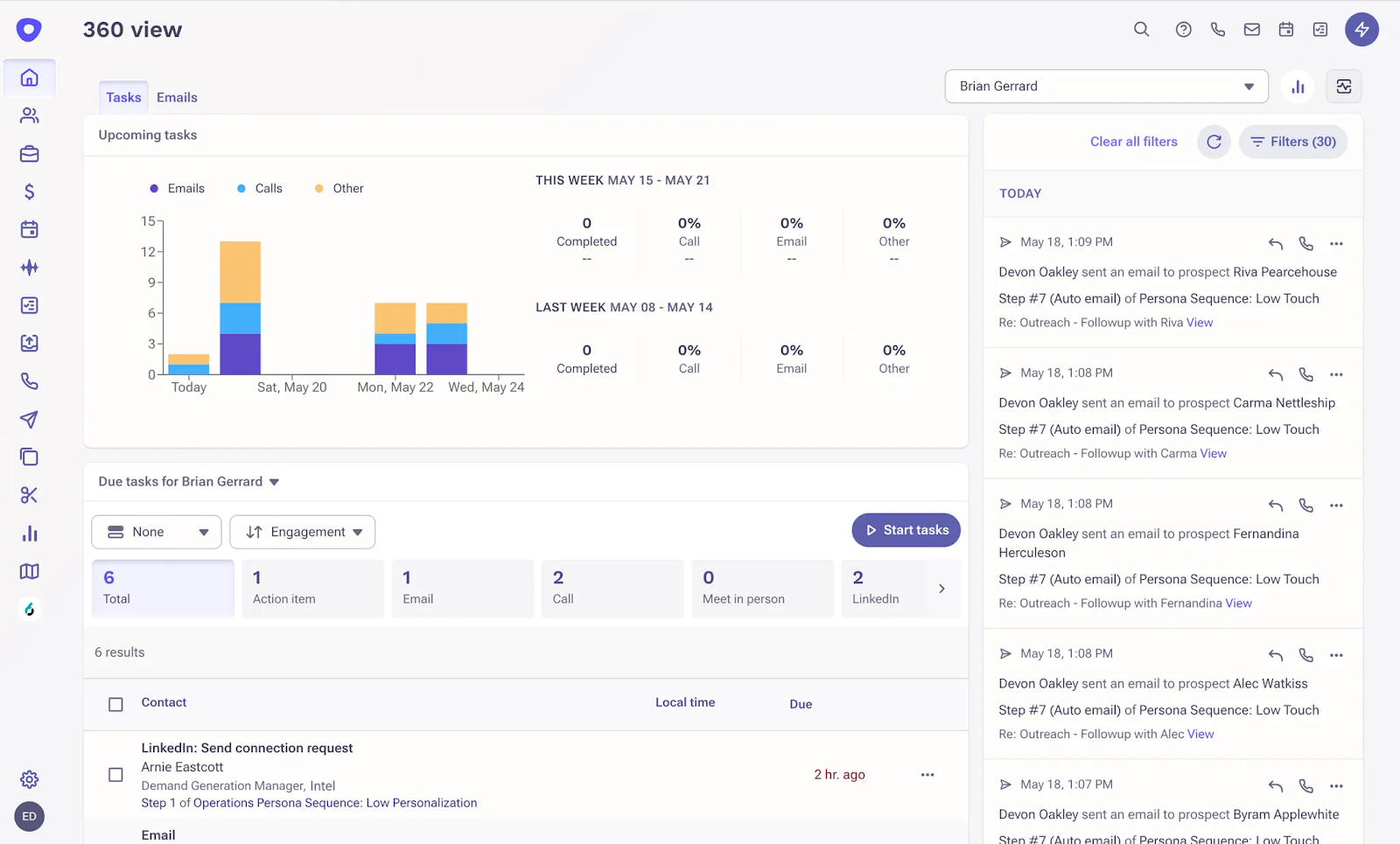
Outreach is an AI-powered sales engagement platform that helps go-to-market teams connect with prospects, communicate the value of their products, and convert them into paying customers.
Unlike traditional CRMs that focus on managing established relationships, Outreach provides tools to streamline prospecting, engage with prospects across several channels, and guide deals from first contact to close.
Key features of Outreach:
- Sales engagement: Lets reps build automated sequences that combine emails, phone calls, and LinkedIn messages. It also uses AI to draft personalized emails, follow-ups, and replies.
- Conversation intelligence: Outreach Kaia™ joins live meetings to provide real-time transcription, highlight action items, and surface relevant content cards during calls. Managers can later review transcripts and recordings to identify coaching opportunities.
- Deal management: Offers a comprehensive pipeline view with health scores for individual deals, so managers can identify risks and focus on high-priority opportunities.
- Sales forecasting: Analyzes activity from previous sales interactions to show reps and managers which deals are likely to close and which aren’t.
- Task prioritization: Allows reps to set priorities (Low, Normal, High, Urgent) for both single tasks and sequences, so they can easily identify high-value prospects and tasks.
How Outreach makes your sales team more productive
Outreach saves reps time by automating prospecting tasks and managing engagement across email, phone, LinkedIn, and more. Instead of jumping between tools, reps can run multi-channel sequences in one platform. AI support makes it faster to personalize messages and send timely follow-ups, so teams can reach more prospects without losing the human touch.
Outreach also gives sales leaders more control over pipeline health. It tracks engagement signals to show which opportunities will likely move forward and which are at risk. Leaders use this data to forecast revenue more accurately, while reps know exactly where to focus their efforts.
4. Calendly – Sales productivity tool for scheduling and managing meetings

Calendly is a web-based scheduling platform that simplifies and automates the process of booking meetings, appointments, and events.
Instead of sending emails back and forth to find a suitable time, Calendly allows reps to share a personalized booking link that shows their real-time availability. Prospects and customers simply pick a time that works, and the meeting is automatically added to both parties’ calendars in the correct time zone.
Key features of Calendly:
- Multiple event types: Supports different kinds of events, including one-off meetings, group events, and round-robin meetings.
- Availability management: Allows reps to set their working hours, create buffer times between calls, and place a limit on the number of daily meetings..
- Automated workflows: Automatically sends meeting confirmations, reminders, and follow-ups via email or SMS to reduce no-shows and keep prospects/customers engaged before and after the meeting.
- Customizable branding: Allows sales teams on paid plans to add logos, brand colors, and personalized messaging to booking pages to provide a professional and on-brand experience.
- Integrations: Syncs with calendars like Google Calendar, Outlook, and Apple Calendar. It also connects with videoconferencing tools (Zoom, Google Meet), CRMs (Salesforce, HubSpot), and payment platforms (Stripe, PayPal).
How Calendly makes your sales team more productive
Calendly speeds up meeting scheduling by replacing endless email exchanges with a simple booking link. Prospects pick a time that works for them, and the platform automatically sends a confirmation email and an email with the meeting link to both parties.
Calendly also helps reps protect their time. By setting limits, buffers, and automated reminders, reps can reduce no-shows and avoid burnout from back-to-back calls. This gives reps more control over their day and ensures they show up to meetings focused and prepared.
5. Apollo.io – Sales productivity tool for sales intelligence and lead data

Apollo.io is an AI-powered sales intelligence and engagement platform that helps reps identify and reach out prospects more efficiently. It provides one of the largest B2B databases and advanced filters, so reps can build prospect lists filled with ideal buyers instead of weak leads.
Beyond prospecting, Apollo streamlines outreach with built-in automation tools, so teams can move from finding leads to engaging them without leaving the platform.
Key features of Apollo.io
- Extensive contact database: Contains over 200 million verified contacts and 60 million companies, giving reps a deep pool of potential buyers to target.
- Advanced filters: Provides 65+ filters such as industry, job title, location, company size, technology stack, and buying intent, which allows reps to zero in on the right prospects.
- Data enrichment: Updates existing records in your CRM automatically with fresh contact and company data, so reps always work with accurate information.
- Sales engagement: Lets reps create automated, multi-step sequences that combine email, phone, and LinkedIn messages. There’s also a built-in dialer to log and track calls.
- Chrome extension: Brings Apollo’s data and engagement tools straight into the browser, so reps can find contact details and engage with prospects directly from LinkedIn or company websites.
How Apollo.io makes your sales team more productive
Apollo.io boosts productivity by reducing the time reps spend hunting for leads. Rather than chase random contacts or rely on outdated lists, reps tap into Apollo’s vast database and precise filters to quickly find qualified prospects and their verified contact details.
From there, they can run multi-channel outreach campaigns (email, phone, and LinkedIn) directly within Apollo, with all activity syncing back to their CRM automatically. By combining data and engagement in one platform, Apollo removes the hassle of switching between tools and helps reps move prospects from first touch to conversion faster.
6. Salesloft – Sales productivity tool for sales engagement and workflow automation
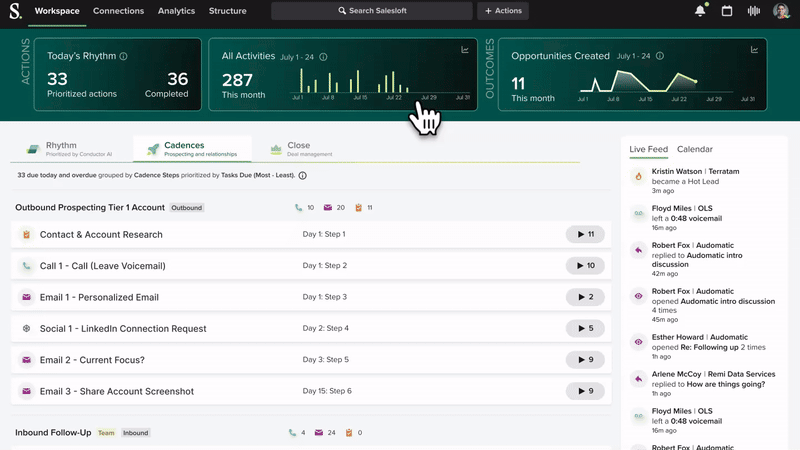
Salesloft brings the entire sales workflow into a single platform, from prospecting and outreach to forecasting and coaching. Reps use it to stay organized, personalize outreach at scale, and keep deals moving forward. Leaders rely on it to view pipeline health in real-time, track performance, and coach reps with data pulled directly from conversations and deal activity.
Key features of Salesloft
- Salesloft Cadences: Users can create structured, multi-channel engagement flows that combine emails, phone calls, and social media interactions to guide prospects through the sales funnel.
- Salesloft Conversations: Automatically records and transcribes sales calls. It also identifies objections, competitor mentions, and buying signals so reps know what to double down on and managers can coach based on real interactions.
- Salesloft Deals: Provides a clear view of the sales pipeline, with AI highlighting risks, recommending next steps, and tracking deal progression in real-time.
- Sales Forecast: Analyzes deal data and historical trends to provide accurate revenue forecasts, which helps leaders set realistic targets and adjust strategies quickly.
- Sales Drift: Uses AI chatbots to connect with website visitors, qualify leads, answer common questions, and route high-value prospects to the right rep.
How Salesloft makes your sales team more productive
Salesloft automates follow-ups, logs activities, and guides outreach across channels, so reps spend less time managing tasks and more time having conversations with buyers. The platform records those conversations and uses AI to highlight what’s working and where to improve, so reps sharpen their skills as they sell.
Managers, on the other hand, get a real-time view of deal progress and rep activity. Salesloft helps them spot risks early, coach reps with data from actual conversations, and build more accurate forecasts. With Salesloft, the entire team spends less energy on admin and more effort moving deals forward.
7. Dock – Sales productivity tool for digital sales rooms and buyer collaboration

Dock.us is an AI-powered revenue enablement platform that allows reps to create shared, branded workspaces for collaboration with prospects, customers, and partners.
By centralizing all shared content, communication, and action items, Dock helps revenue teams (including Sales, Customer Success, and Marketing) streamline onboarding, close deals faster, and drive renewals.
Key features:
- Centralized resource hub: Organizes all customer-facing content, such as proposals, case studies, pricing sheets, contracts, and demo videos into one easy-to-access location.
- Digital Sales Rooms: Create branded, private portals where buyers can review materials, ask questions, and collaborate directly with the sales team.
- Customizable templates: Standardize follow-ups and presentations with pre-built templates that auto-populate with customer-specific details pulled from the CRM.
- Mutual Action Plans: Build shared timelines and to-do lists that assign responsibilities to both buyer and seller, with automated reminders to keep deals on track.
- Engagement tracking: Track which documents buyers view, how long they spend on each, and what they share internally. This gives reps insight into buyer interest and helps tailor the next conversation.
How Dock makes your sales team more productive
Since Dock centralizes all deal-related content in a single digital sales room, reps don’t waste time hunting down or resending files. Buyers always know where to find the latest proposal, pricing sheet, or case study, which reduces friction and keeps the sales process moving forward.
Dock also shows reps which materials prospects spend time on, where interest is strongest, and where momentum may be fading. So instead of guessing, reps know exactly which resources are most effective at converting prospects.
8. Salesforce – Sales productivity tool for managing pipeline and account activity

Salesforce is a CRM (Customer Relationship Management) tool that consolidates customer data, automates sales, marketing, and service processes, and gathers customer insights for businesses.
So, instead of relying on spreadsheets or disconnected tools, reps and managers get a complete view of every account and opportunity, allowing them to prioritize the right leads, stay on top of customer activity, and close deals confidently.
Key features of Salesforce:
- Account and contact management: Organizes all customer information, including contact details, communication history, and key decision-makers, in one place.
- Process automation: Automates repetitive tasks like sending proposal reminders, scheduling meetings, and updating deal stages.
- Opportunity management: Allow sales reps to track deals in a visual pipeline so they can monitor the progress of each opportunity through different sales stages.
- Sales forecasting: Provides accurate sales forecasts based on real-time data, so managers can predict future sales performance and make informed decisions.
- Activity tracking: Logs sales activities like emails, calls, and meetings, ensuring all interactions are recorded and visible to the entire team.
- Customizable dashboards and reports: Allows reps to tailor their data visualization and analysis to specific business needs.
How Salesforce makes your sales team more productive
Salesforce centralizes all customer information, including communication history, past purchases, and service interactions, into a single "source of truth," giving sales reps a complete 360-degree view of their clients. With this available in one place, reps don’t have to spend time searching through different systems or inputting data by hand.
Salesforce also automates routine tasks, such as lead assignment, data entry, follow-up emails, and proposal generation, which reduces manual effort and minimizes human error. This frees up time for sales reps to work on higher-value tasks like prospecting, nurturing relationships, and ultimately closing more deals.
9. HubSpot – For marketing automation and lead nurturing
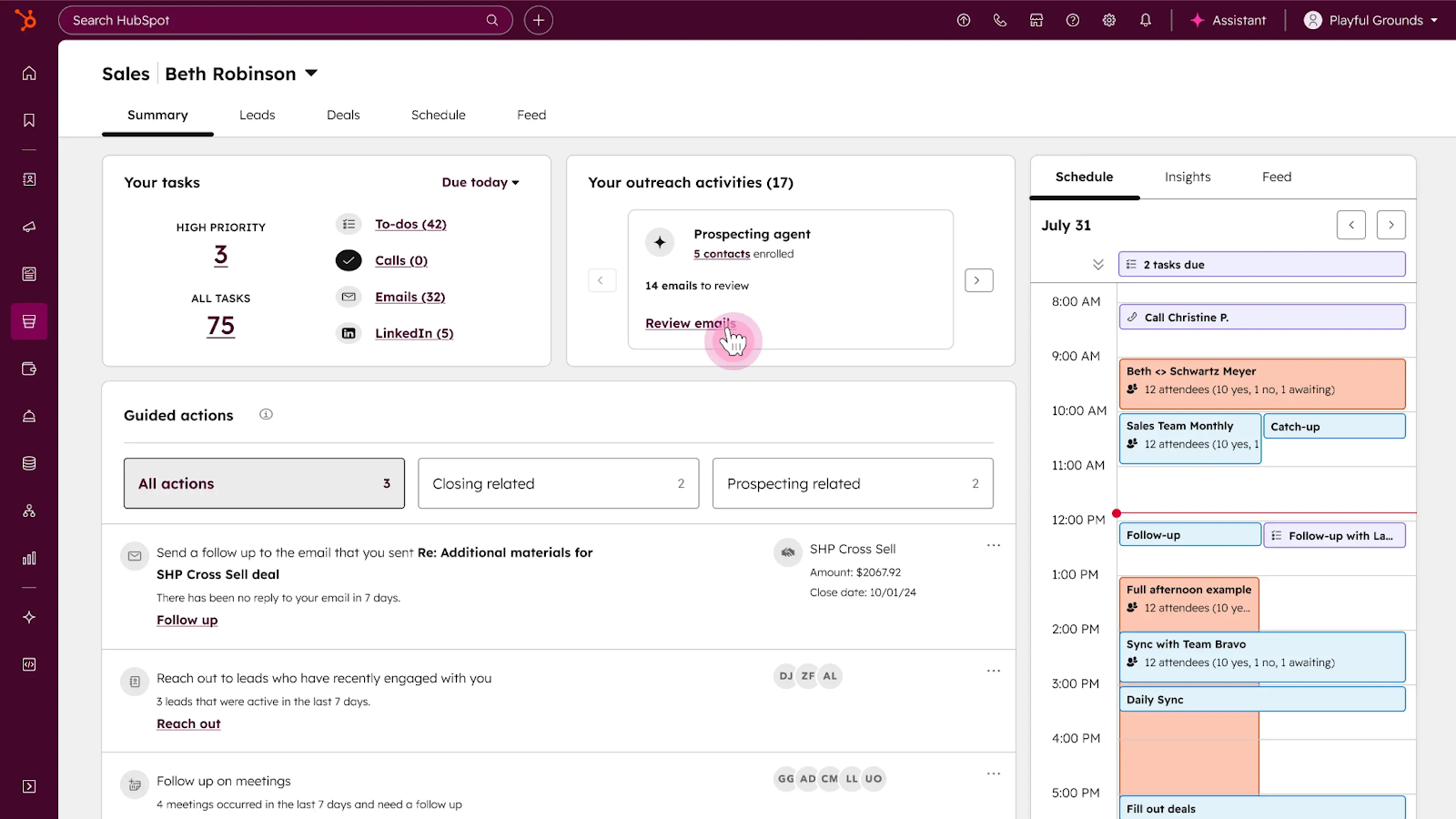
HubSpot is an AI-powered platform that brings marketing, sales, service, and operations tools (called Hubs) into one unified system. Built on a single CRM, it connects every stage of the customer journey, helping businesses attract visitors, convert leads, and retain customers without juggling disconnected software.
Key features of HubSpot:
- Smart CRM: Stores and organizes all customer and prospect data (emails, calls, website visits, and support tickets) in a single database, giving reps and managers a complete picture of each relationship.
- Sales Hub: Helps reps identify high-value leads, automate email and call sequences, and access a library of sales scripts and resources.
- Marketing Hub: Helps marketers build landing pages, publish blog posts, optimize website content, run targeted email campaigns, and manage social media activity.
- Content Hub: A CMS that allows marketers and developers to create and optimize websites, blogs, podcasts, and other assets.
- Service Hub: Centralizes customer service operations with a ticketing system, knowledge base, chatbots, live chat, and survey tools, so service reps can resolve issues more efficiently.
- Operations Hub: Automates repetitive workflows, syncs data across systems like Salesforce or Microsoft Dynamics, and improves data accuracy through data cleansing and enrichment.
How HubSpot makes your sales team more productive
HubSpot’s Sales Hub helps reps focus on the deals most likely to close. With lead scoring, they can immediately see which prospects are sales-ready, while automated outreach and follow-ups keep those leads warm without extra effort from the rep.
Because Sales Hub integrates with Marketing Hub, reps also get full visibility into a prospect’s journey before the first call. For example, what content they’ve engaged with, which campaigns they’ve responded to, and how they’ve interacted with the brand. That context helps them personalize conversations and nurture leads better.
The forecasting and pipeline management tools also help managers direct their teams toward the deals that matter most.
10. ChatGPT - Sales productivity tool for accelerating sales workflows with conversational AI
ChatGPT is an AI-powered chatbot developed by OpenAI that uses a Large Language Model (LLM) to understand complex queries and generate human-like text. For sales teams, it acts as a digital assistant, helping reps brainstorm ideas, write personalized outreach, summarize calls, and automate routine tasks.
Key features:
- Natural Language Understanding (NLU) and Generation (NLG): ChatGPT can understand detailed prompts and generate clear, personalized responses. This allows reps to use it to build Ideal Customer Profiles (ICPs), tailor cold emails, and craft messaging that resonates with each buyer segment.
- Conversational ability: It remembers context within a conversation, allowing reps to refine their prompts, ask follow-up questions, and iterate in real time.
- Role-playing: ChatGPT can simulate a buyer, prospect, or coach, so reps can practice discovery calls, handle objections, or refine pitches before going live.
- Voice and image capabilities: With GPT-4o, users can talk to ChatGPT or upload screenshots and visuals. This allows reps to do vocal roleplays and analyze visual assets (like a sales deck or email screenshot) for feedback.
- Workflow automation: By using ChatGPT for Business or integrating with other tools through an API, salespeople can automate tasks like updating CRM notes or sending follow-ups.
- Custom GPTs and Integrations: Teams can build custom versions of ChatGPT for specific tasks, such as a “Sales Coach GPT” for training or an “Email Assistant GPT” for outreach.
How ChatGPT makes your sales team more productive
ChatGPT helps sales teams be more productive by automating repetitive, creative, and administrative tasks, such as researching prospects, drafting personalized emails, and summarizing calls. It can also refine messaging for specific buyer personas, reducing manual work and helping reps communicate more effectively.
Beyond automation, ChatGPT can be used to roleplay calls, practice handling objections, or test different outreach approaches until they find what works best. This allows teams to continually improve and sell with confidence.
Read: How to use ChatGPT for sales
11. Zapier – Sales productivity tool for connecting apps and automating workflows
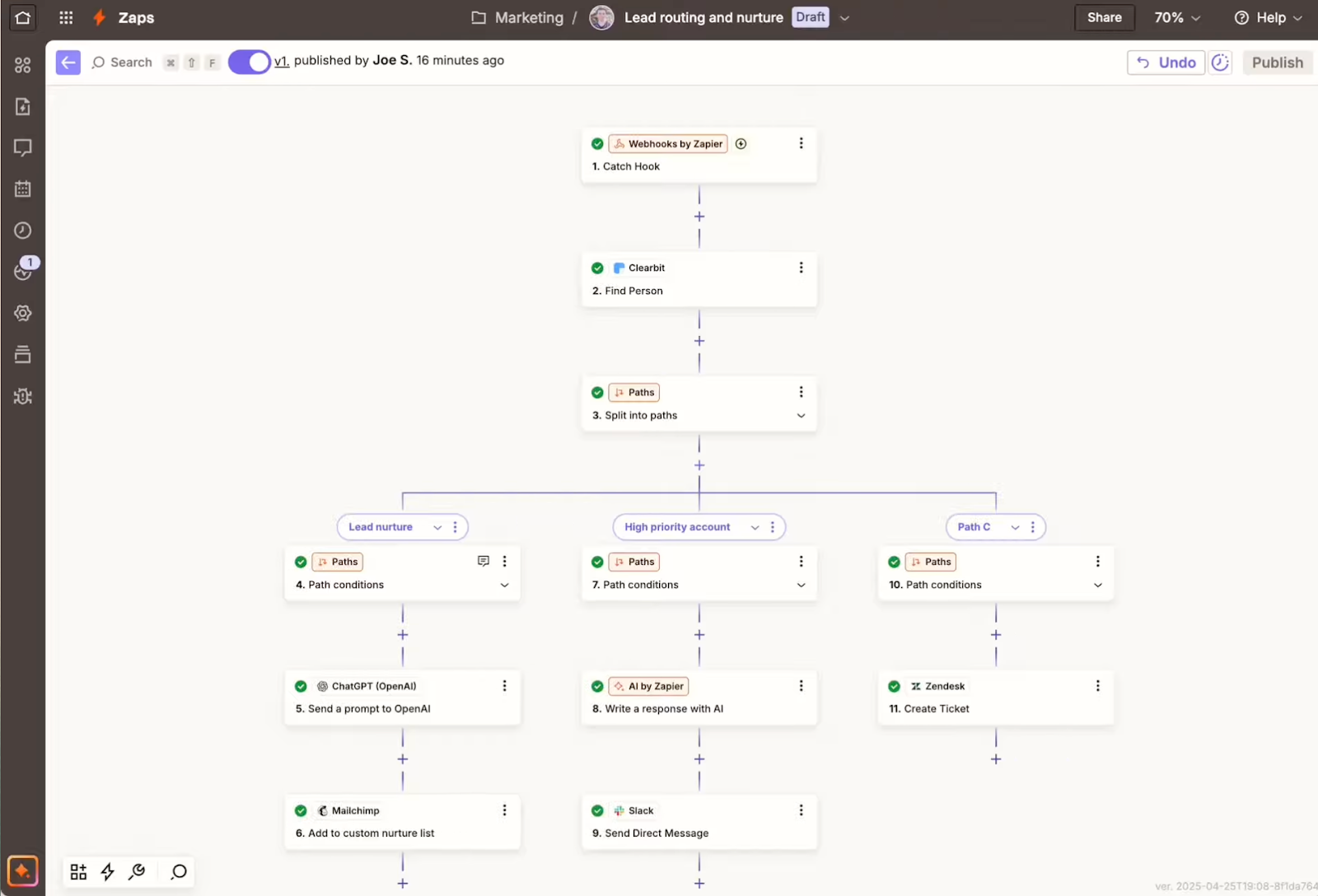
Zapier is a no-code automation tool that connects thousands of apps and services, allowing them to work together seamlessly. Reps build automated workflows, called “Zaps”, by defining a “trigger” event in one app that kicks off “actions” in others. For example, when someone fills out a web form, Zapier will instantly create a lead in the CRM, send a confirmation email, and notify the right rep in Slack.
By setting up Zaps, sales teams can eliminate repetitive tasks such as moving data between systems, logging activity, or sending follow-ups.
Key features of Zapier:
- Zap templates: Ready-made workflows for everyday tasks (like syncing leads from forms to your CRM) that teams can customize, so they don’t have to build everything from scratch.
- AI-powered assistance: Copilot helps users build Zaps by describing their workflow in plain English, while Canvas creates visual diagrams that map out complex automations step-by-step.
- Agents: Create autonomous AI agents that can monitor triggers and perform tasks across apps without user input.
- Filters and Paths: Add conditional logic to workflows, e.g., only send a Slack alert if a lead’s deal size is above a certain threshold, or branch follow-up emails based on prospect behavior.
- Tables: A built-in database for storing, editing, and automating structured data, which can also fuel AI-driven workflows.
- Interfaces: Build no-code web pages, forms, and interactive tools that connect directly to Zaps, making it easier for teams to capture and act on data.
How Zapier makes your sales team more productive
Zapier helps sales teams faster by handling the repetitive tasks that eat up selling time. So, instead of copying data between a CRM, email platform, and project tool, reps can build workflows that do it automatically. This means they spend less time updating systems and more time talking to prospects, running demos, and closing deals.
Zapier also creates smoother lead management. Zaps can capture new leads the moment they come in, route them to the right rep, and trigger personalized follow-ups, all without anyone lifting a finger. Activity logs stay clean and up to date, so managers always have an accurate view of the pipeline.
12. Asana – Sales productivity tool for task and project management
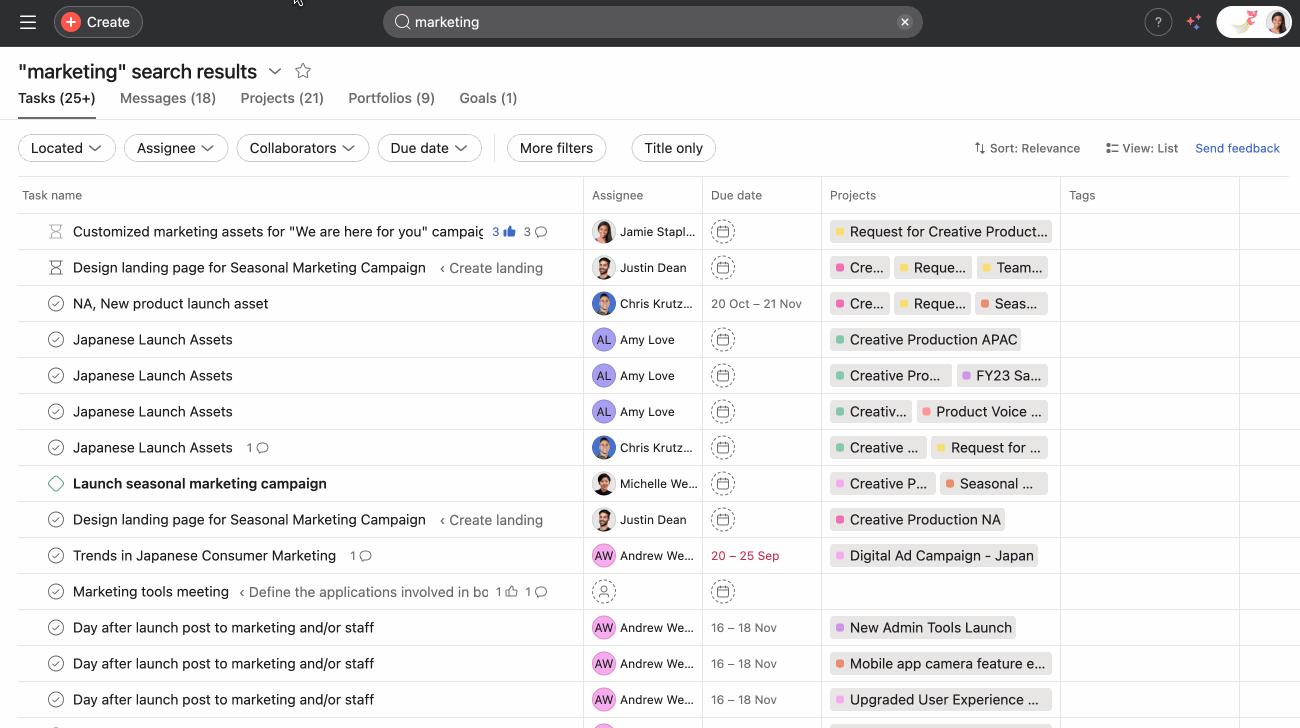
Asana is a cloud-based work management platform that helps teams organize, track, and manage their work in one place. For sales teams, it provides a central hub where reps can manage their pipeline, prioritize tasks, and collaborate without relying on scattered spreadsheets or email threads.
Asana’s flexibility makes it just as useful for managing lead outreach and account planning as it is for coordinating product launches or marketing campaigns.
Key features of Asana:
- Multiple project views: Asana allows reps to visualize the pipeline in the format that works best. Such as: Kanban boards for deal stages, list view for task details, timeline view for long-term initiatives, or calendar view for meeting deadlines.
- Custom fields: Create custom fields like deal size, lead priority, or region to quickly filter and sort tasks.
- Rules: Automate repetitive sales processes, like assigning a follow-up task when a deal moves to the next stage or tagging a manager when a large opportunity enters the pipeline.
- Task dependencies: Link tasks together so reps know exactly what needs to be done first, e.g., confirming pricing approval before sending a proposal.
- My tasks: A personalized to-do list for each sales rep that aggregates all tasks assigned to them across different projects.
- Portfolios: Gives a single, aggregated view of the progress of multiple projects, allowing reps and managers to track strategic initiatives and spot risky accounts.
How Asana makes your sales team more productive
Asana helps sales reps stay organized by turning every opportunity, follow-up, and account activity into a trackable task. Reps can manage their pipeline visually, see what’s urgent at a glance, and use custom templates to standardize key processes like lead outreach or renewal management. This structure reduces busywork and ensures that follow-ups are timely.
Asana also automates handoffs and workflows for reps. When a deal moves to “closed-won” in a CRM like Salesforce, Asana can automatically assign tasks to customer success for onboarding. Sales managers benefit from real-time visibility into progress and workloads, so they can coach reps more effectively and adjust strategies when needed.
13. Second Nature – Sales productivity tool for AI-powered sales roleplays and training
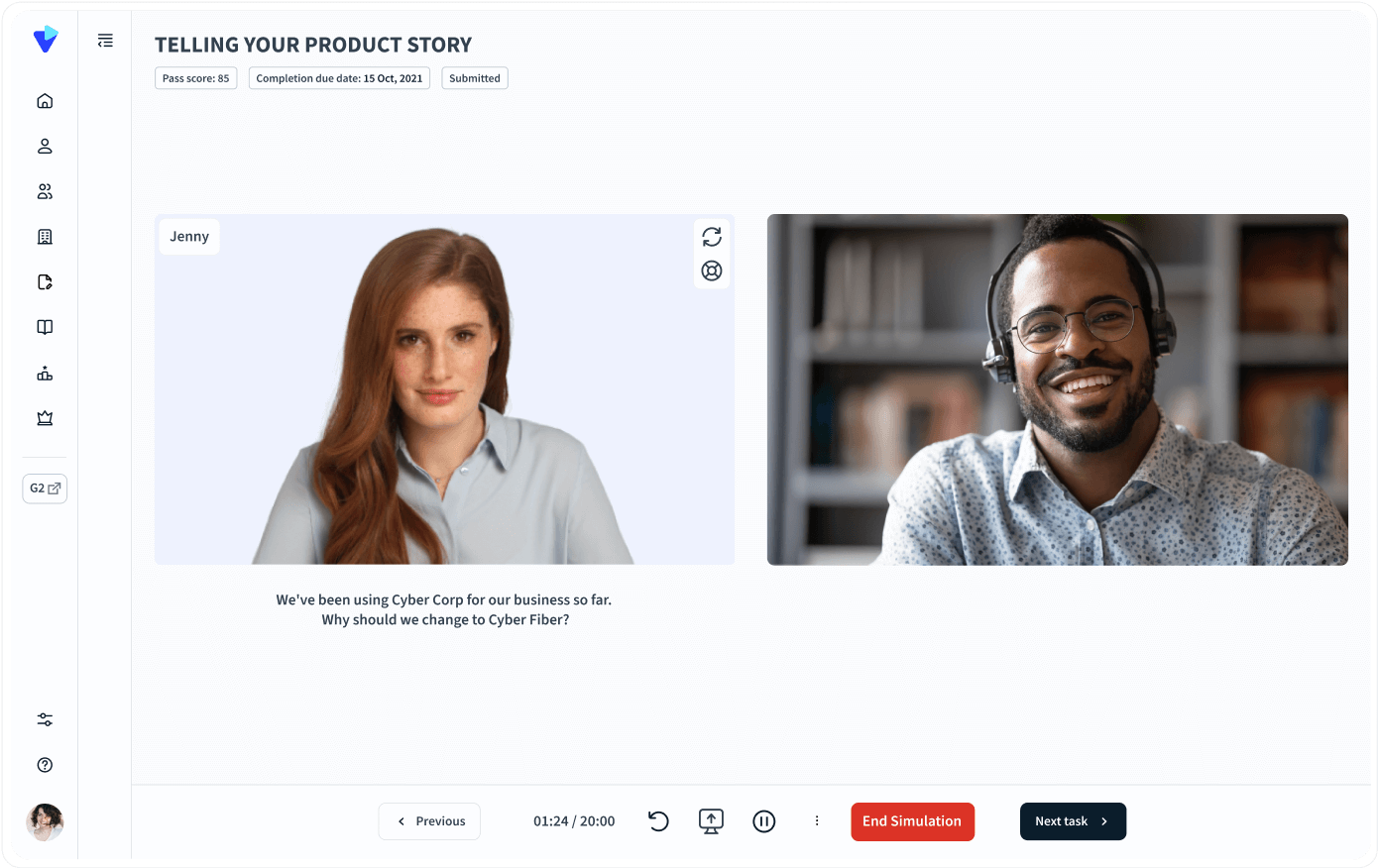
Second Nature is an AI-powered sales coaching platform that helps reps practice conversations in a safe, simulated environment. Instead of waiting for a manager, reps can have realistic voice and video conversations with an AI avatar, receive instant feedback, and sharpen their skills on demand. This makes training scalable, consistent, and more effective for both new hires and experienced sellers.
Key features:
- Realistic AI simulations: Reps interact with an AI avatar names Jenny, who’s designed to behave like a real buyer by asking tough questions, raising objections, and adapting her tone or persona to different scenarios.
- Multiple role-play formats: Supports live voice conversations, video calls, pitch recordings, and even product demos with screen sharing to mimic real-world selling situations.
- Customizable scenarios: Sales leaders can build tailored training modules by uploading decks, call recordings, scripts, or collateral. The AI assistant can also automatically generate new scenarios.
- Real-time feedback: Trainees receive immediate, personalized feedback on their delivery, including pace, tone, clarity, energy, and adherence to company messaging.
- Automated scoring: Evaluates each session objectively, scoring both knowledge (topic coverage, product accuracy) and style (energy, clarity, confidence).
- Analytics dashboard: Gives managers a centralized view of rep progress and performance trends over time, so they don’t have to manually review every call.
How Second Nature makes your sales team more productive
Second Nature helps sales teams ramp faster by replacing time-consuming manager-led roleplays with on-demand AI simulations. This way, reps can practice pitches, refine messaging, and learn to handle objections in a pressure-free environment, building confidence and competence much faster.
Second Nature also gives reps clear, data-driven feedback after every session, showing them exactly where to improve. And managers can track rep progress in the analytics dashboard without having to listen to hours of call recordings.
14. Storydoc – Sales productivity tool for creating interactive presentations and sales decks
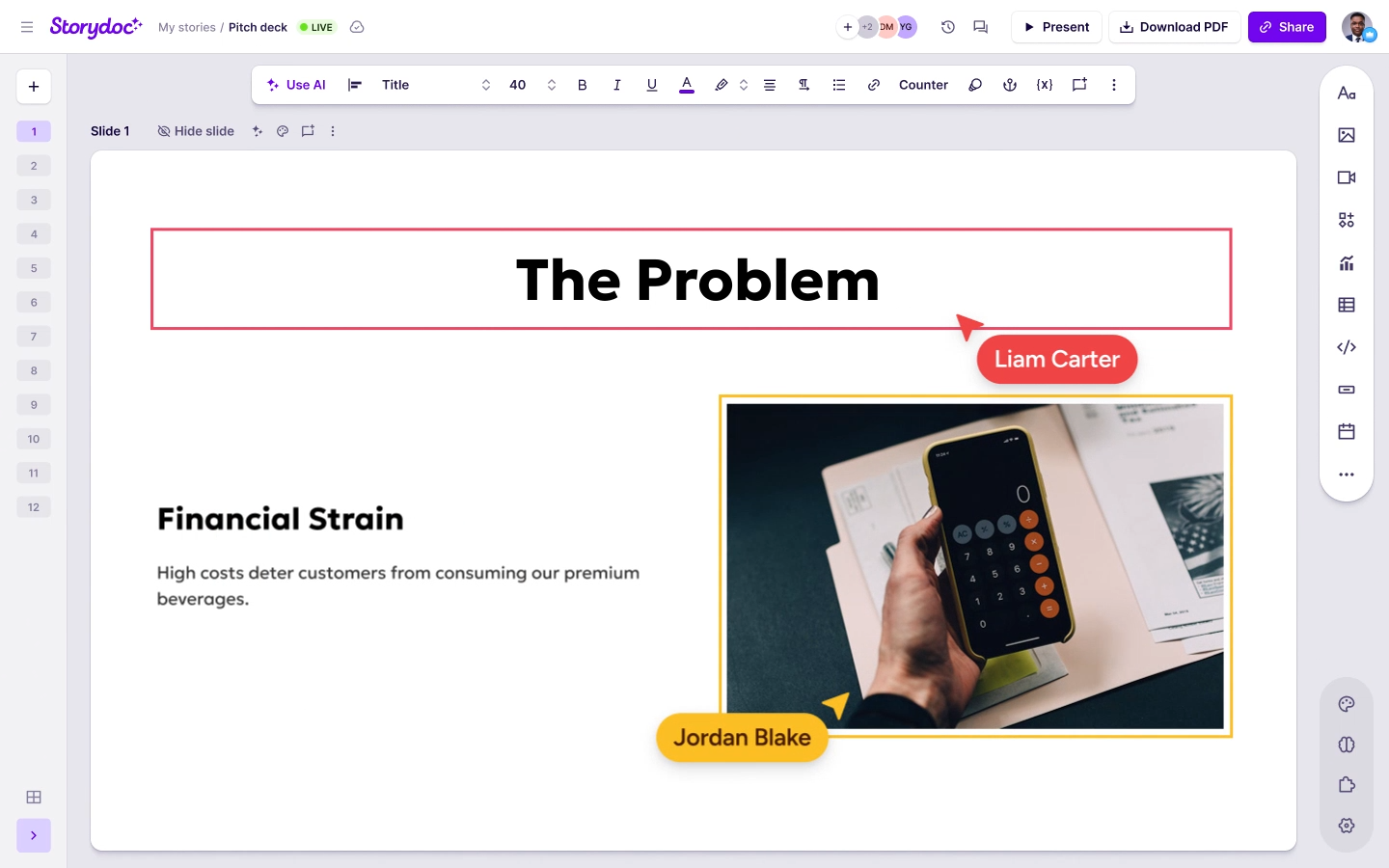
Storydoc is an AI-powered platform that transforms static PDFs and presentation slides into engaging and personalized documents, known as "Storydocs". By using a no-code editor, sales reps can quickly generate pitch decks, proposals, reports, and onboarding guides that are mobile-responsive and trackable.
This allows teams to gather deep analytics on viewer engagement and tailor their follow-up strategy based on prospect activity.
Key features of Storydoc:
- AI generator: Creates a polished first draft of a presentation or proposal from a simple prompt, uploaded slides, a URL, or text.
- AI editing assistant: Rewrites or refines copy and automatically adjusts slide layouts and designs to maintain a professional, on-brand look.
- Dynamic media embeds: Add interactive elements, such as Calendly scheduling links, YouTube videos, Loom recordings, forms, and dynamic charts, to documents.
- Personalization: Automatically generate tailored versions of a deck for individual prospects by pulling variables from a CRM.
- E-signature and payments: Close deals directly inside proposals by integrating e-signatures and payment services like DocuSign and Stripe.
- Deep analytics: Tracks and reports on viewer behavior in real-time, including who opened the document, time spent on each slide, and where they dropped off.
How Storydoc makes your sales team more productive
Storydoc saves hours on manual design work by automating the creation of polished, personalized sales collateral. Instead of wrestling with PowerPoint slides or sending static PDFs, reps can generate interactive decks in minutes and adapt them for each buyer.
Storydoc also provides teams with visibility into buyer behavior that static documents cannot offer. Reps see exactly when a prospect opens a deck, which sections they spend the most time on, and when they disengage. These insights help reps focus on the hottest leads and reach out at the right moment.
15. Trainual – Sales productivity tool for content management and process documentation
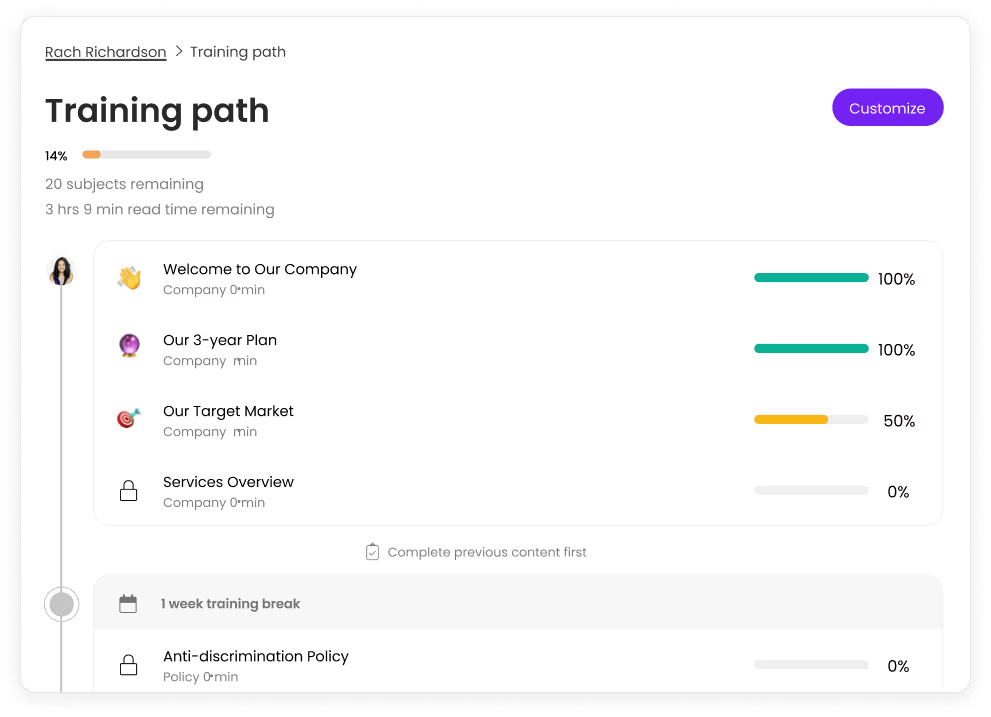
Trainual is a training and documentation platform that creates a single source of truth for company knowledge, including SOPs, wikis, templates, policies, and training materials.
For sales teams specifically, it centralizes playbooks, product details, scripts, and procedures into one searchable hub, so reps always know where to find answers.
Key features of Trainual:
- Centralized hub: Houses all sales-related resources, like pitch decks, objection-handling scripts, product FAQs, and pricing policies, so reps can find what they need easily.
- AI-powered content generation: Writes, edits, and refines documentation and training modules for sales teams.
- Templates: Offers over 400 customizable templates for common processes, such as employee onboarding, contract renewals, and objection-handling, so teams don’t have to start from scratch.
- Automated onboarding: Assigns training modules automatically to reps based on their role, department, location, or product focus.
- Mobile access: A mobile app and web platform allow employees to access training materials anytime, anywhere, which is ideal for remote and hybrid sales teams.
How Trainual makes your sales team more productive
Trainual centralizes all sales processes, product knowledge, and procedures into a single, accessible playbook. Instead of waiting on a manager or digging through scattered folders, reps can quickly find answers to questions about product features, pricing, or objection handling.
The platform also eases the workload for managers. Automated onboarding and progress tracking mean they don’t have to repeat the same training sessions for every new hire or hold meetings to gauge each rep’s skills. This gives managers more time to focus on coaching and supporting their team.
16. Chili Piper - Sales productivity tool for lead routing and call scheduling
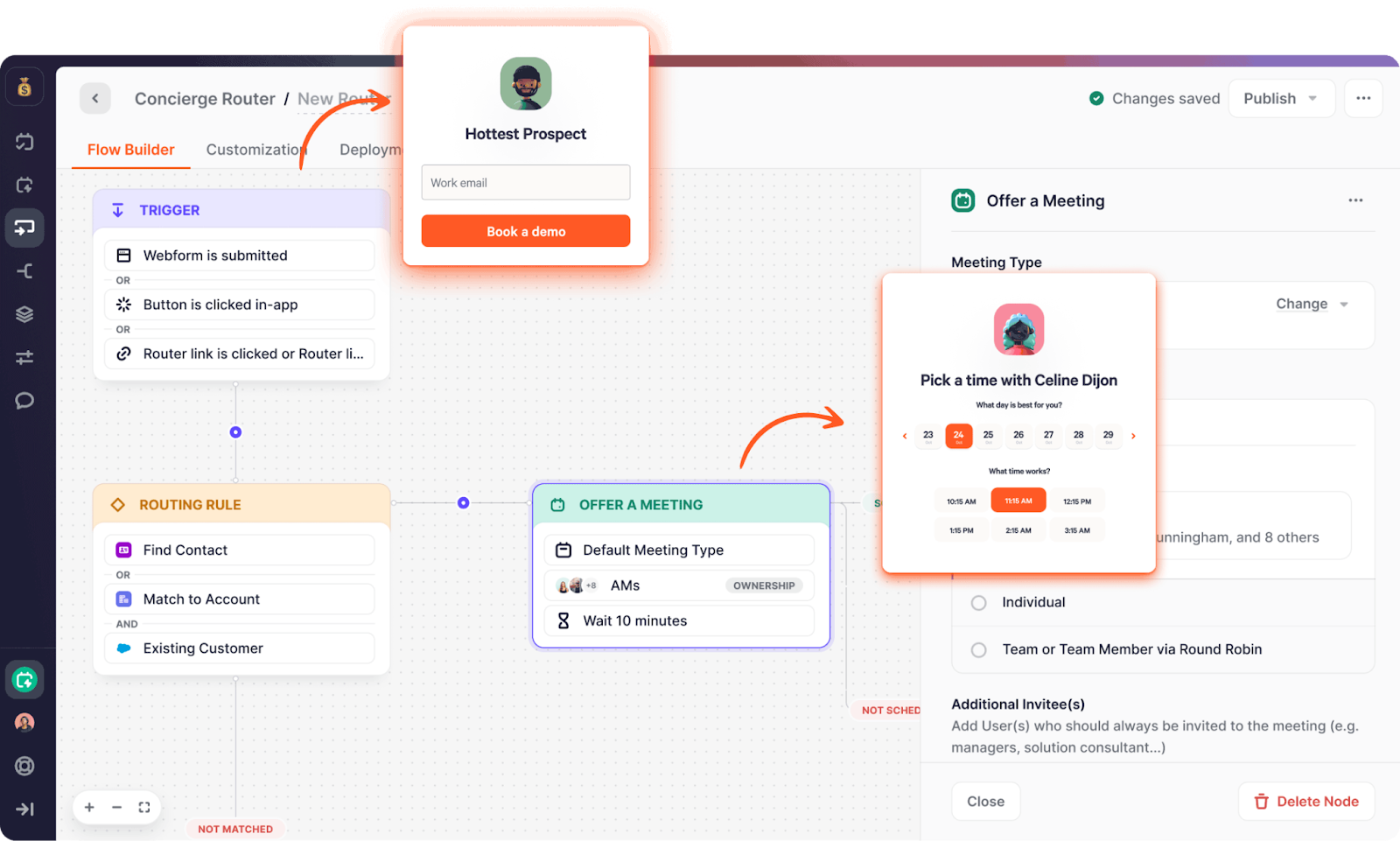
Chili Piper is a demand conversion platform that helps turn inbound leads into qualified meetings by automating scheduling from start to finish. Instead of letting leads sit in inboxes or get lost in back-and-forth coordination, Chili Piper instantly qualifies, routes, and books them with the right rep.
Because the platform handles confirmations, reminders, and calendar updates automatically, reps can skip the admin work and focus on selling.
Key features of Chili Piper:
- Webform concierge: Transforms standard website forms into conversion engines by qualifying and routing leads the moment they submit, and then offering immediate booking options.
- Instant booking: Embeds real-time availability into emails, forms, and landing pages. Prospects can select a time slot with one click, and the meeting is automatically confirmed and logged.
- Intelligent lead routing: Uses rules like geography, deal size, or industry to connect each lead with the best-fit rep, or distributes them evenly across the team with round-robin routing.
- Live chat: Combines real-time chat with instant scheduling, so visitors can connect with reps live while interest is high.
- Team handoff: Automates the handoff process between different revenue teams, such as between a Sales Development Rep (SDR) and an Account Executive (AE).
How Chili Piper makes your sales team more productive
Chili Piper automates one of the biggest time drains in sales: scheduling. When a qualified lead submits a form, Chili Piper instantly routes it to the right rep and prompts immediate booking. This way, reps no longer have to spend hours on back-and-forth emails, and prospects don’t wait days to hear back.
This fast response turns interest into live conversations sooner, helping reps convert more leads into opportunities.
17. DocuSign – Sales productivity tool for e-signatures and contract management

DocuSign is a digital agreement platform that helps sales teams prepare, send, and close legally binding contracts faster. Instead of chasing signatures through printing, scanning, or emailing PDFs back and forth, reps can send documents electronically and have them signed from any device.
This speeds up the closing process by removing the friction that often causes deals to stall at the finish line.
Key features:
- Legally binding signatures: DocuSign eSignatures are secure, legally recognized, and compliant with global regulations, including the U.S. ESIGN Act and the EU's eIDAS regulation.
- Mobile accessibility: Reps and customers can review, send, and sign documents from smartphones or tablets, keeping deals moving even outside the office.
- Reusable templates: Create templates for frequently used documents, like NDAs, contracts, and order forms, to ensure consistency and reduce prep work.
- Web forms and PowerForms: Generate on-demand, self-service agreements that prospects can access through a secure URL or embedded form.
- Audit trail: DocuSign logs every activity (viewing, signing, forwarding, or printing) into a tamper-proof audit trail, providing both legal compliance and clear visibility into the signing process.
How DocuSign makes your sales team more productive
DocuSign eliminates the paperwork bottlenecks that often slow deals down. With this platform, reps can generate contracts, send them instantly, and get them signed without leaving their CRM. With templates and automated workflows, agreements are prepared quickly and with fewer errors, allowing reps to focus on selling.
DocuSign also gives teams visibility into deal progress. Reps and managers can see the status of every contract, spot delays, and trigger automatic reminders for unsigned documents.
Give your reps the tools to sell smarter and faster
Sales productivity tools can only positively impact your team’s productivity if they’re used. But too often, platforms sit outside the daily workflow, forcing reps to pause mid-task and search through another system for the answers they need. This context switching slows down deals and frustrates the very people the tools are meant to help.
Spekit eliminates this by unifying content management, enablement, and personalized AI guidance in one platform. With AI Sidekick, Spekit uses signals from your CRM, call intelligence, and communication platforms to deliver tailored recommendations, training, and resources directly within the tools your team already uses.
Want to see how? Book a demo with Spekit today.




